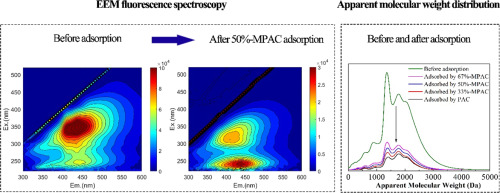Science of the Total Environment ( IF 8.2 ) Pub Date : 2020-01-03 , DOI: 10.1016/j.scitotenv.2019.136423 Zhuqing Feng , Huilun Chen , Haiqing Li , Rongfang Yuan , Fei Wang , Zhongbing Chen , Beihai Zhou

|
In view of the urgent need for tertiary treatment of papermaking wastewater and the difficulty in separating powdered activated carbon (PAC) from water, the magnetic activated carbon (33%-MPAC, 50%-MPAC and 67%-MPAC) were prepared by chemical coprecipitation method for adsorption of biologically treated papermaking wastewater (BTPW). A series of characterization of MPAC and PAC were carried out and show that the content of iron oxides is negatively related to the proportion of micropores in MPAC. The loaded iron oxides is mainly the mixture of magnetite and maghemite, and the maximum saturation magnetization of MPAC can reach 29.68 emu/g. Batch mode experiments were performed, and found that the adsorption effect of MPAC is slightly worse than that of PAC, the adsorption capacity of COD in MPAC can reach about 65 mg/g, and pH = 2 and 10 °C are more favorable for adsorption. The adsorption isotherms and kinetics were well fitted by the Freundlich model and pseudo-second-order kinetic model, respectively. The selective adsorption was studied by using the excitation emission matrix (EEM) fluorescence spectrum and high-performance size exclusion chromatography (HPSEC). It is concluded that all adsorbents are preferred to adsorb humic acid-like substances (HA). And all adsorbents are preferred to adsorb low apparent molecular weight substances (LAMW, AMW < 1500 Da), with the increase of iron oxides content, the phenomenon of MPAC preferentially adsorbed LAMW became less obvious.
中文翻译:

磁性活性炭的制备,表征及在生物处理造纸废水处理中的应用
鉴于迫切需要对造纸废水进行三级处理,并且难以从水中分离出粉末状活性炭(PAC),因此可以通过化学方法制备磁性活性炭(33%-MPAC,50%-MPAC和67%-MPAC)共沉淀法吸附生物处理造纸废水(BTPW)。对MPAC和PAC进行了一系列表征,结果表明,氧化铁的含量与MPAC中微孔的比例负相关。负载的氧化铁主要是磁铁矿和磁赤铁矿的混合物,MPAC的最大饱和磁化强度可达到29.68 emu / g。进行了分批模式实验,发现MPAC的吸附效果比PAC差一些,COD在MPAC中的吸附容量可以达到65 mg / g,pH = 2和10°C更有利于吸附。吸附等温线和动力学分别通过Freundlich模型和伪二级动力学模型很好地拟合。通过使用激发发射矩阵(EEM)荧光光谱和高性能尺寸排阻色谱(HPSEC)研究了选择性吸附。结论是所有吸附剂均优选吸附类腐殖酸(HA)。并且所有吸附剂都优选吸附低表观分子量的物质(LAMW,AMW <1500 Da),随着铁氧化物含量的增加,MPAC优先吸附LAMW的现象变得不那么明显。利用激发发射矩阵(EEM)荧光光谱和高效液相色谱法(HPSEC)研究了选择性吸附。结论是所有吸附剂均优选吸附类腐殖酸(HA)。并且所有吸附剂都优选吸附低表观分子量的物质(LAMW,AMW <1500 Da),随着铁氧化物含量的增加,MPAC优先吸附LAMW的现象变得不那么明显。利用激发发射矩阵(EEM)荧光光谱和高效液相色谱法(HPSEC)研究了选择性吸附。结论是所有吸附剂均优选吸附类腐殖酸(HA)。并且所有吸附剂都优选吸附低表观分子量的物质(LAMW,AMW <1500 Da),随着铁氧化物含量的增加,MPAC优先吸附LAMW的现象变得不那么明显。







































 京公网安备 11010802027423号
京公网安备 11010802027423号